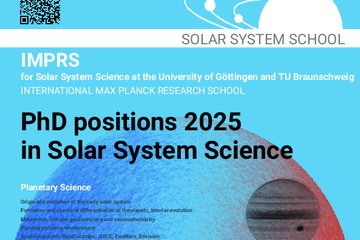All genres
21.
Journal Article
The association of coronal mass ejections with their effects near the Earth. Annales Geophysicae 23, pp. 1033 - 1059 (2005)
22.
Journal Article
Comparison between halo CME expansion speeds observed on the Sun, the related shock transit speeds to earth and corresponding ejecta speeds at 1 AU. Solar Physics 222 (2), pp. 323 - 328 (2004)
23.
Journal Article
The phase curve of cometary dust: Observations of comet 96P/Machholz 1 at large phase angle with the SOHO LASCO C3 coronagraph. Astronomy and Astrophysics 427 (2), pp. 755 - 761 (2004)
24.
Journal Article
Observacione de la corona solar. Ciencia Hoy 14, pp. 20 - 29 (2004)
25.
Journal Article
Continuous tracking of CMEs using MICA, and LASCO C2 and C3 coronagraphs. Advances in Space Research 32 (12), pp. 2625 - 2630 (2003)
26.
Journal Article
Relation between the radial speed and the expansion speed of coronal mass ejections. Advances in Space Research 32 (12), pp. 2637 - 2640 (2003)
27.
Journal Article
Coronal mass ejection speeds measured in the solar corona using LASCO C2 and C3 images. Advances in Space Research 32 (12), pp. 2619 - 2624 (2003)
28.
Journal Article
Launch of solar coronal mass ejections and submillimeter pulse bursts. Journal Geophysical Research 108 (A7), 1280 (2003)
29.
Journal Article
On the solar origin of interplanetary disturbances observed in the vicinity of the Earth. Annales Geophysicae 21 (4), pp. 847 - 862 (2003)
30.
Journal Article
Interplanetary phenomena associated with very intense geomagnetic storms. Journal of Atmospheric and Solar-Terrestrial Physics 64 (2), pp. 173 - 181 (2002)
31.
Journal Article
Variability of magnetospheric storms driven by different solar wind perturbations. Journal Geophysical Research 107 (A7), 1121 (2002)
32.
Journal Article
Solar Orbiter, a high-resolution mission to the Sun and inner heliosphere. Advances in Space Research 29, pp. 2027 - 2040 (2002)
33.
Journal Article
New insights on the onsets of coronal mass ejections from SOHO. Advances in Space Research 29 (10), pp. 1473 - 1488 (2002)
34.
Journal Article
The eruptive events on September 30, 1998: 1. The jet. Journal Geophysical Research 106, p. 25239 (2001)
35.
Journal Article
Ionization state and magnetic topology of coronal mass ejections. Journal Geophysical Research 106 (A6), pp. 10597 - 10613 (2001)
36.
Journal Article
Large Doppler shifts in X-ray plasma: An explosive start to coronal mass ejection. Astrophysical Journal 549, pp. L249 - L252 (2001)
37.
Journal Article
Long-term variations of the flow direction and angular momentum of the solar wind observed by Helios. Astronomy and Astrophysics 366, pp. 331 - 338 (2001)
38.
Journal Article
Sonnenwind und Weltraumwetter. Spektrum der Wissenschaft, Dossier 3, pp. 15 - 23 (2001)
39.
Journal Article
Hot cores in coronal filament channels. Advances in Space Research 25, pp. 1859 - 1861 (2000)
40.
Journal Article
Coronal mass ejections and large scale structure of the corona. Advances in Space Research 25, pp. 1843 - 1846 (2000)











